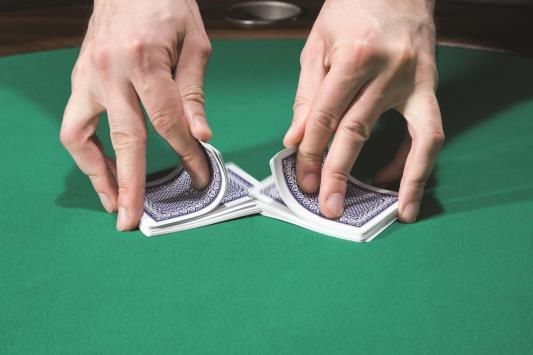
5 minute read
SHUFFLE TRACKING
An In-Depth Explanation
Shuffle tracking is the science of following specific cards through the shuffling process and either keeping them in play or cutting them out of play in the game of blackjack.
Most blackjack players don't think the "cut" of the cards makes much difference, but nothing could be further from the truth. Players use the shuffle as a break. A professional player who has been keeping track of the cards can take advantage of this opportunity by placing the cut card to keep good cards in play.
This is a fairly new technique that has not been publicized very much. The concept of shuffle tracking appears to have resulted from bored mathematicians’ research and computer simulation of shuffling cards. Of course, just because cards are shuffled does not mean that they are randomized. Both basic strategy and card counting assume a random order of cards. A six deck shoe takes 120 to 180 shuffles to ensure a truly random dispersion. Like most players, you were probably oblivious to how the shuffle happens at a blackjack table. Pay attention and you can gain an additional advantage in your blackjack play.
There are a number of shuffle methods, some of which have been labeled as: “Zone Shuffle,” “The Strip Shuffle” and the “Stutter Shuffle.” The Zone Shuffle is particular to shoe games and is probably one of the most common shuffle methods. It is accomplished by splitting the shoe into 4 to 8 piles depending on the number of decks in the shoe. Prescribed picks from each pile are made in a very exact way with intermittent shuffles of each pair of half deck sized stacks. The net effect is a simple regrouping of the cards pretty much in the same region of the shoe as they were before, thereby preventing clumps of cards from being randomly mixed.
If the dealer won 40 hands and you won 20, this trend is likely to continue until you are broke or until the unfavorable bias is removed through many shuffles. What if players are winning 40 hands and the dealer only 20? If the dealer has been mentally keeping track of how many hands each side has won in the shoe, the dealer will probably do one of two things. One is to keep the shuffle the same, but "strip" the deck. When a dealer strips, they strip off one card at a time from the shoe letting them fall on top of one another onto the table. This action causes the order of the cards to be reversed. The main consequence is to dissipate any clumping advantages that the player may have. The second thing the dealer may do is simply change the way they shuffle to help randomize the cards.
tion to the way they shuffle. Many times a dealer will ask who wants to cut the cards, volunteer so that you can place the cut card to gain an advantage.
In Arizona, where they use shuffle machines, you must pay close attention to where the cut card was placed in the previous shoe of that color of cards. I have found that if the cards were favorable for the player in the previous shoe, cut the opposite of the previous cut. For example, if the last cut was towards the bottom and it was favorable, cut towards the top to keep those cards in play. If they were not good for the player, cut the same as the previous cut to keep the unfavorable cards out of play. You will be surprised how this affects the cards.
When the casino changes cards they are never randomized and it seems that the 10s are clumped at the bottom of the decks. When the cards are placed in the shuffler, it basically just mixes the cards in groups of five and they stay in that order. Here is what happens when most of the tens are at the bottom of the shoe. The small cards will come out giving the player stiff hands like 12, 13, 14, etc.
Then the dealer will show an up card of six or less. The player will split their pairs, double and catch small cards, stand on their stiffs, not making hands since the tens are clumped at the bottom. The dealer will then usually make his hand. Even worse the card counter will get a high plus count which tells them to increase the bet, expecting to get good hands, but instead stiff hands continue to come out and the dealer wins. If you notice this happening you can get the 10s in play by cutting the deck deep towards the bottom and this will get the 10s toward the top. Incorporate shuffle tracking into your blackjack play for an additional advantage. $
Writer TJ Jorgensen has been a professional Blackjack player for several decades. He is well known for his tournament play and has beaten some of the top tournament players in the world. He has also won the World Series Of Blackjack. His newest book “How To Become A Blackjack Jedi” is available online at Amazon.com.








